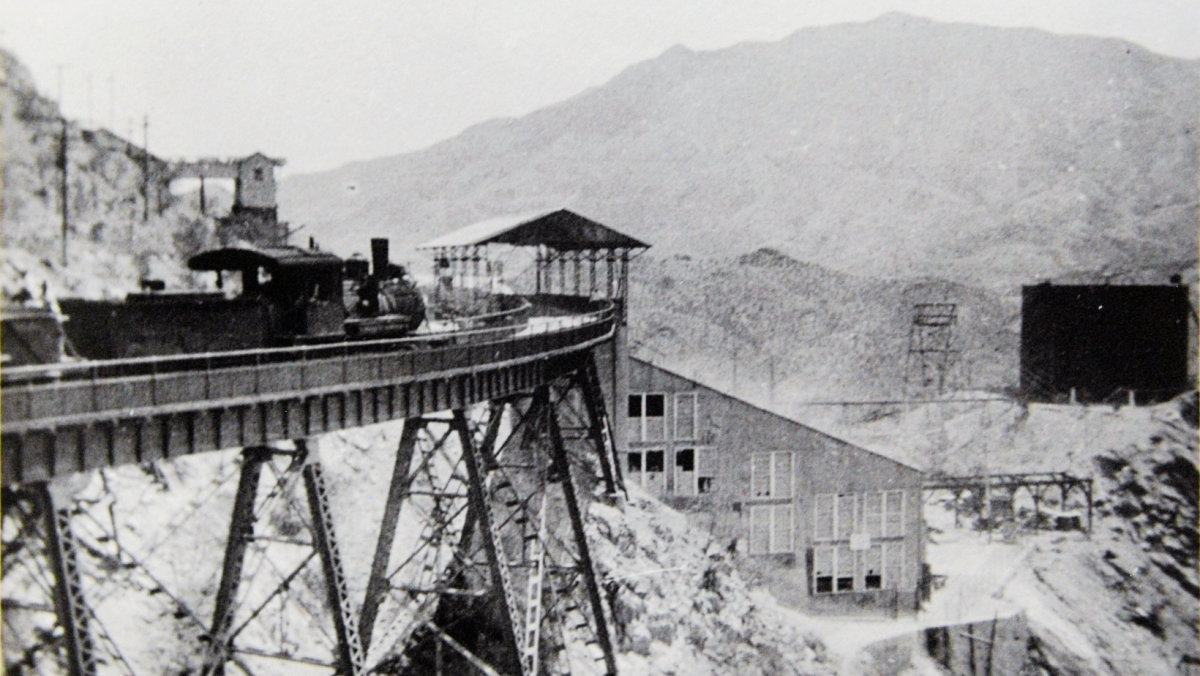
Nacozari’s Immense Mining Industries (1909)
20 de enero de 2023
By Frank Aley
I have just returned from the south, having gone as far as Nacozari Viejo, which is about six miles south of the camp of Nacozari, locally known as “Placeritos”, the latter at the terminus of the Nacozari railroad.
Little trips such as this settle controversy, dispose of idle report, and reflect facts from the standpoint of observation. In a former communication, I have outlined the extent of the S. P. operations in that locality and the approximate effort that is in process at the present time, from where the public may, from its own concession as to the ultimate outcome, now deal with the Moctezuma Copper Company and the general industrial complexion of the district.
In regard to the manner in which the splendid virgin Suaqui de Batuc and Sahuaripa districts are opening up in expectation of the advent of a railroad, I could only speak from hearsay, but it is evident that the new field is exceedingly enticing to frontier spirit and bold capital. Messrs, Jones, Shattuck, and others of Bisbee, with Ed Austin and Cap. Blackman and Charlie Cunningham as fieldmen have denounced broad possessions in those districts, while Dr. Fisher and others of Douglas are deeply interested and thoroughly informed in regard to their merit from personal investigation.
Whether the revenues are products of these districts will flow northward or down to the ports of the S. P. in the event of their occupation and development, waits to be seen, but some patronage, at least, will come through the port of Douglas, which, it is clearly to be seen, will shortly be the most important port of entry between Nogales and Juarez.
It was supposed for years that the port which supplied Cananea and through which her products were brought out of the republic would be the most prominent along the line, but this idea has long since evaporated.
The Moctezuma district leads distantly in northern Sonora. This has been demonstrated by the operations of the Moctezuma Copper Company at Nacozari, successors to the Guggenheims.
The west coast region, embracing the Magdalena, Altar, Hermosillo, Guaymas, and Alamos districts, is not in its class. Nothing to compare with the Moctezuma district is in evidence anywhere else in Sonora and that district is strictly tributary to Douglas. I speak from experience, travel, and observation. There is greater confidence, greater activity, and greater prosperity in the Moctezuma district today that in any other mineral subdivision of the state.
At Nacozari Viejo I took pictures of the primitive adobe smelters of the antiguas, who brought ores down from the San Pedro mine on the one hand, and the old Fortuna district under the direction of the Jesuits nearly 300 years ago, and next from the ruins of the little old Guhhenheim smelter, which undertook the first modern enterprise in the same direction on the same properties.
During all these years, copper was never considered, except in the light of incumbrance in their operations. The only object was the recovery of silver. Then, the Guggenheims came into possession of the mighty Pilares, but with all their financial and commercial acumen, they never dreamed of what they had, and they sold their “birthright” to the Moctezuma Copper Company for a mess of pottage. Discovering later on what they had parted with, they sought to retrieve the disaster by re-entering the district and endeavoring to discover a position of equivalent merit.
They gathered up the Caridad, developed it to a point where it began to take on a prosperous complexion, then allowed it to revert and it became the property of the Harris company, which since its occupation bids fair to develop a mine that almost rivals the Pilares itself.
The Moctezuma Copper Company, a branch of the Phelps-Dodge system, started out with a smelter at Nacozari, then known as Placeritos. This smelter was run in connection with a concentrator of a normal capacity of 500 tons, but which could be crowded to 750. For long years, they ran together, the ores averaging about 3.5 percent copper, with a slender byproduct in the form of gold.
When the big Copper Queen smelter was completed in Douglas, the smelter at Nacozari was shut down and the concentrates shipped to this point. The ore is handled from the mine, which is six miles southeast of Nacozari down to that point on a narrow-gauge railroad built on the most substantial plan, laid with 80-pound steel and ballasted to the rim with slang, with 25-ton cars and 60-ton engines.
At the mine, everything is lighted and handled by electricity. The engine uncoupled, the trolley takes charge of the ore train and pulls it into the one-mile tunnel on the seventh level, which is supplied with chutes, accommodating the ore from every level above it; the train is loaded in a few minutes, brought out and turned over to the engine. At the present time, the product of the mine amounts to about 1,500 tons per 24 hours, all of which is brought down to the new concentrator, perhaps the finest reduction plant in the southwest.
The faithful old concentrator closed down in October, and, to one who was accustomed to listen to the hum and road of industry which emanated from it and to the mighty pounding and churning of the old gas engines, the solitude which now prevails in and about the works is profoundly impressive.
The new concentrator was put into operation, percent by percent and it is now practically in full commission at 1,500 tons per day, though its capacity could easily be raised to 1,800, and could be crowded to 2,000. It is built on the most modern and approved plan, the ground being selected with rare judgment with a view to the slope, elevation, and general lay, and the mighty foundation floor, each representing a concrete retaining wall of 20 to 30 feet in height, with a width of several hundred feet, would suggest the plans of a fortification. These run up like terraces one above the other, upon which the building is erected and the machinery mounted.

The greatest level being the Pilares high line, or narrow gauge, before mentioned, which covers the bin, then the powerful proass crusher and proass rollers, the jigs, the table, and the tanks, a mere mention of which should be taken up individually and would require columns, until the tailings pass away through two tunnels, each several hundred feet long to disgorge in the bosom of the Nacozari river.
Usually, the management relies on the annual floods to relieve the situation, but that cannot always be depended on. Even if those occur as per expectation, they may only cut a comparatively narrow channel through the heavy slimes, and leave the conditions approximately as bad as ever. On any event, the situation could not be vitally serious.
The new powerhouse is the wonder of all visitors who have even an outside notion of power, its production, and the means by which it is applied to reduction plants.
This powerhouse, while not representing the aggregate capacity of the great Copper Queen powerhouse at Douglas, is distinctly more modern and up-to-date. Its plan is the production by steam of electricity, by which the reduction plant and other departments of the great system are operated.
The powerhouse, in boiled-down terms, consists of four sterling boilers with coal burners. Should the questions of economy be raised as between coal and oil, in this particular instance, it might be easily disposed of by referring to the fact that the company owns the Dawson coal field, but it does not own any oil field.
The steam supplies three steam turbines. Those turbines are of the vertical type and the shaft which they turn continues through three electric generators so that every revolution of the turbine represents a revolution of the generator. Now, these turbines make as high as 80 revolutions per minute and the generator the same, with the almost phenomenal result that one generator supplies electricity with which the concentrator operates, transmits to Pilares, Porvenir, operates trollers and hoists at that point lights Nacozari and perform a multitude of minor offices which were called to my attention.
The amount of improvement accomplished in Nacozari so quietly that even the ubiquitous newspaper man has yet never fully comprehended is marvelous. A city laid out regularly, not a tent, not a shack; a crew of brick and stone and concrete, these people do business while others talk. To make a camp out of 3.1 percent copper requires calculation even in Mexico. It has been done.
The public privileges and luxuries provided by the company should have recognition. The neatest, nattiest, most artistically designed, best finished, and most finely furnished gymnasium, where the Mexican is welcome and the Gringo feels at home, where the long evenings in a strange and foreign community may be spending absolute comfort, sanitary conditions perfect, as good hotel accommodations, with Mrs. Manly at the register, as could be asked, with the privilege of trading, eating and sleeping where you please, make Nacozari the most agreeable stopover place and an outfitting place for the ambitious tenderfoot who would beard Dam Fortune in her den.
All over the district, there are fine inducements for the American mine and prospector, but none for the working man or farmer.
Stock raising also, though the range is glorious, is very precarious. A few Chinamen make gardening stock, and aside from that, mining is about the only industry in evidence.
The Moctezuma district represents mining, more mining, colossal mining, and Douglas is sure to get the greatest benefit from the unfolding of this magnificent field and out to publish its merits to the world.
Published on The Bisbee Daily Review
Bisbee, Arizona, January 10, 1909
Cover Photo: Railroad over coarse ore bins (1923) Nacozari de García | Arizona Historical Society
About the author:
Frank “Mescal” Aley (1860-1910) was an Arizona pioneer, lawyer, newspaperman, and renowned mining writer in the early 20th century. He was also a mineralogist, humorist, and writer who used the pen name “Mescal”. Aley worked as a journalist and mining reporter for various newspapers in Arizona, including the Bisbee Daily Review, Tombstone American, and Douglas newspapers. He covered and reported extensively on the booming mining camps and districts in Arizona and Sonora, Mexico, gaining expertise in the mining industry.
© All Rights Reserved
